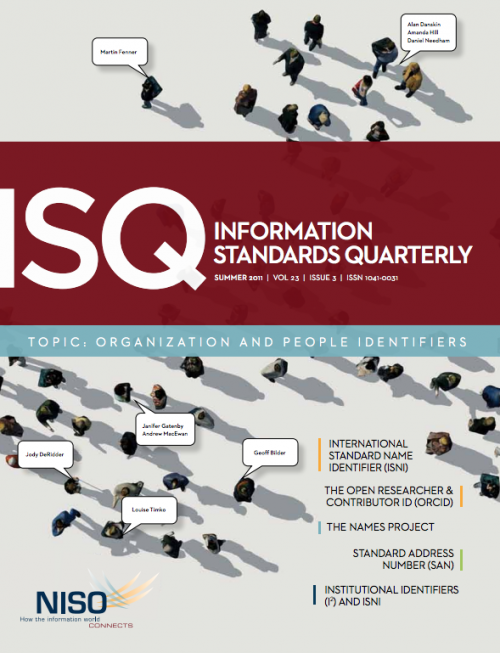Letter from the Editor
Identifiers have always been essential standards in libraries and publishing. content identifiers, such as the ISbn, are well established, but institutional and personal identifiers are much newer, the need having emerged as more and more content is available electronically. this issue of ISQ looks at existing and new institutional and people identifiers, how they have developed, and what new initiatives are underway in this area.
My interest in identifiers started in my initial training as a geologist and my subsequent library and information experience over 40 years. I have always wanted to put things into categories or “boxes.” In 1996, I was working with a team developing an innovative hosting platform and had lively discussions with many people about how the arrival of scholarly electronic publication meant that it was time to start systematically identifying users and usage. I suggested that if you could have identifiers for the content, the user, the rights, and the time period, you could automatically provide access to everything one was entitled to see. Every January the listservs demonstrate that this still isn’t the case, with plaintive pleas asking who has lost access to what.
However, 15 years later it seems that the time may have finally come when there is a universal recognition of this requirement. Geoff Bilder expresses this eloquently in his opinion piece pointing out the importance of trust in the electronic world. I was involved in the initial Journal Supply Chain pilot which tried to highlight the “points of pain” in the process of getting e-journal content from the supplier to the user. This pilot was picked up by NISO and evolved into the Institutional Identifiers (I2) Working Group. Jody deRidder summarizes the findings of this Working Group and their final selection of the International Standard Name Identifier (ISNI) as their working identifier. The development of the ISNI has been a thorough and comprehensive exercise within the International Organization for Standardization (ISO), with many parties having interests and needing their requirements met. Janifer Gatenby of OCLC has been a key part of that initiative and has also contributed considerably to the I2 Working Group. She and Andrew McEwan of the British Library describe the architecture and operation of the ISNI system, which will bring together many different name identification registries. Louise Timko makes a plea for the “less glamorous” but no less essential SAN (Standard Address Number), which is a key part of the publishing supply chain.
Identification of researchers has been a hot topic for some years and with bigger investments in institutional repositories this need has only increased. The JISC funded Names Project is summarized by Alan Daskin, Amanda Hill, and Daniel Needham. Publishers have started many fragmented author identifier schemes, but finally there is some collaboration between them and the academic community. Martin Fenner describes ORCID (The Open Researcher and Contributor ID), the ambitious initiative to bring all these schemes together and perhaps even work with the ISNI.
The papers in this issue do show that not only has the need for institutional and personal identifiers been recognized, but there is increasing collaboration between the constituent parts of the scholarly community to make sure that not only are the standards developed but they are also implemented.
The company I founded, Ringgold, has a continuing interest in institutional identification, but I am now moving back to my consultancy roots where I can put things into boxes for others.
Helen Henderson | Managing Director at Information Power Ltd
